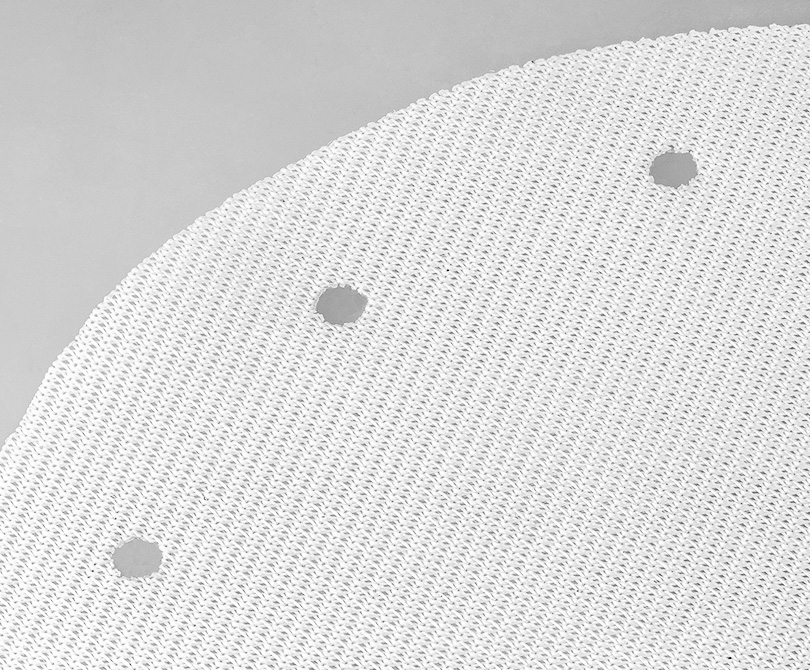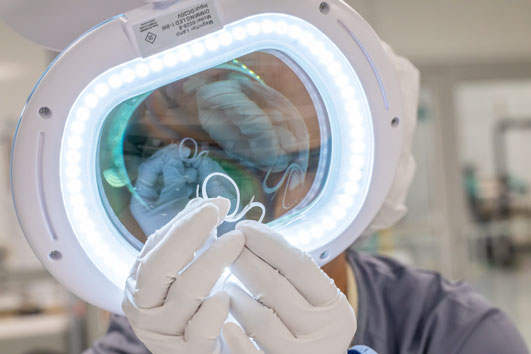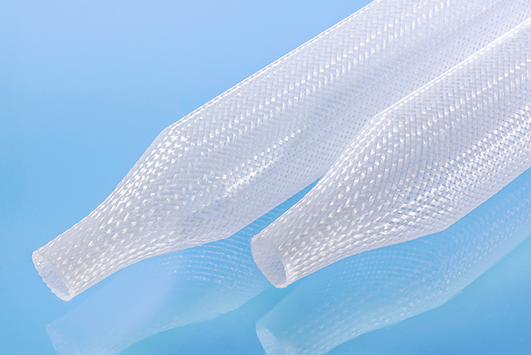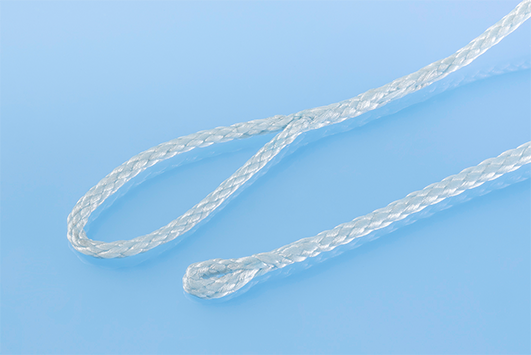
Today’s medical textiles benefit from a wide array of post-processing technologies to ensure performance in the operating room and better outcomes for patients.
![]()
Post-Processing and Added-Value Capabilities for Biomedical Textiles
Today’s medical textiles benefit from a wide array of post-processing technologies to ensure performance in the operating room and better outcomes for patients.
![]()
Today’s biomedical textile structures are integrated into modern surgery in new and innovative ways that require highly specialized performance and delivery. We have added a suite of post-processing services and technologies that provide your implantable fabric or device in its final form, which helps you streamline your product delivery and minimize additional suppliers. Today, designs can be highly complex and textile manufacturing can contain many processes – all of which may be customized for a specific product and which must meet the guidelines of ISO 13485. Cortland is proud to offer our medical device OEM customers expertise and solutions for:
- Spin Finish Removal
Spin finish can improve the properties for processability of implantable fibers including improved filament cohesions during weaving, knitting, twisting, and braiding, reduced friction, abrasion resistance, and more. In our experience, removal of spin finish may improve the biocompatibility of implantable fibers. - Edge Sealing
Edge sealing is performed by using a variety of proprietary methods to apply heat and/or weld materials to minimize loose fibers and/or fraying without impacting the base material. For biomedical applications, heat treatment of edges can help stabilize the implant and mitigate stresses that may impede longevity and performance. - Ultrasonic Welding
Ultrasonic welding is a process that creates a weld by specialized application of high-frequency vibratory energy while textiles and other materials are held together under pressure. Implantable fabrics with complex geometries can benefit from the highly precise applications of heat to create complex shapes via the attachments of components, etc. - Heat Pressing
Heat pressing provides the ability to further specialize and alter braided, woven, and knit textiles to stabilize and improve their performance. With the growing need for smaller, thinner materials, heat pressing can also improve surface profiles to be smoother for better utilization in minimally invasive applications. - Shape Setting
Shape setting and thermal forming are processes that are employed to set a fabric into a specific and often complex geometry to suit a specific surgical application. Starting with one shape (e.g., flat, tubular, conical) thermal energy is used to further form the textile to complement an anatomical structure or device. - Braid Tipping
Our tipping services ensure that your braided products are manufactured for optimal performance by stiffening the ends to reduce fraying. This allows for easier assembly, insertion, and precise, cut-to-length pieces. - Laser cutting
Highly precise laser cutting solutions from Cortland Biomedical provide almost endless possibilities for the design and manufacturing of smaller components. Our post-processing laser cutting services are customized to your unique application, delivering the quality and compliance needed for precision medical applications.
Implantable textiles can be formed via knitting, braiding or weaving of medical-grade fibers. Based on the processing parameters and biomaterials selected (such as, ultra-high molecular weight polyethylene, polyester, polypropylene etc.), the characteristics of the fabric can be tailored by design engineers to the specific needs of the surgical application with our post-processing solutions. Contact us to learn more today.



Today’s biomedical textile structures are integrated into modern surgery in new and innovative ways that require highly specialized performance and delivery. We have added a suite of post-processing services and technologies that provide your implantable fabric or device in its final form, which helps you streamline your product delivery and minimize additional suppliers. Today, designs can be highly complex and textile manufacturing can contain many processes – all of which may be customized for a specific product and which must meet the guidelines of ISO 13485. Cortland is proud to offer our medical device OEM customers expertise and solutions for:
- Spin Finish Removal
Spin finish can improve the properties for processability of implantable fibers including improved filament cohesions during weaving, knitting, twisting, and braiding, reduced friction, abrasion resistance, and more. In our experience, removal of spin finish may improve the biocompatibility of implantable fibers. - Edge Sealing
Edge sealing is performed by using a variety of proprietary methods to apply heat and/or weld materials to minimize loose fibers and/or fraying without impacting the base material. For biomedical applications, heat treatment of edges can help stabilize the implant and mitigate stresses that may impede longevity and performance. - Ultrasonic Welding
Ultrasonic welding is a process that creates a weld by specialized application of high-frequency vibratory energy while textiles and other materials are held together under pressure. Implantable fabrics with complex geometries can benefit from the highly precise applications of heat to create complex shapes via the attachments of components, etc. - Heat Pressing
Heat pressing provides the ability to further specialize and alter braided, woven, and knit textiles to stabilize and improve their performance. With the growing need for smaller, thinner materials, heat pressing can also improve surface profiles to be smoother for better utilization in minimally invasive applications. - Shape Setting
Shape setting and thermal forming are processes that are employed to set a fabric into a specific and often complex geometry to suit a specific surgical application. Starting with one shape (e.g., flat, tubular, conical) thermal energy is used to further form the textile to complement an anatomical structure or device. - Braid Tipping
Our tipping services ensure that your braided products are manufactured for optimal performance by stiffening the ends to reduce fraying. This allows for easier assembly, insertion, and precise, cut-to-length pieces. - Laser cutting
Highly precise laser cutting solutions from Cortland Biomedical provide almost endless possibilities for the design and manufacturing of smaller components. Our post-processing laser cutting services are customized to your unique application, delivering the quality and compliance needed for precision medical applications.
Implantable textiles can be formed via knitting, braiding or weaving of medical-grade fibers. Based on the processing parameters and biomaterials selected (such as, ultra-high molecular weight polyethylene, polyester, polypropylene etc.), the characteristics of the fabric can be tailored by design engineers to the specific needs of the surgical application with our post-processing solutions. Contact us to learn more today.






